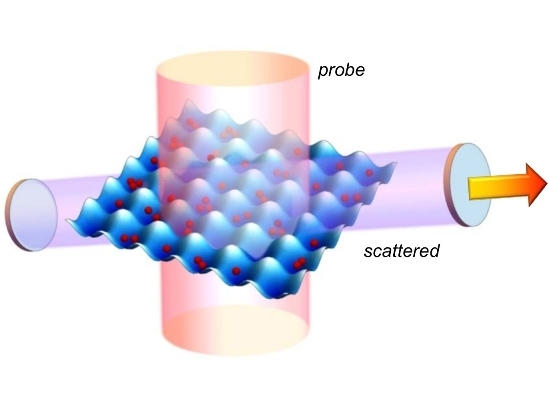Probing and Manipulating Fermionic and Bosonic Quantum Gases with Quantum Light
Abstract
:1. Introduction
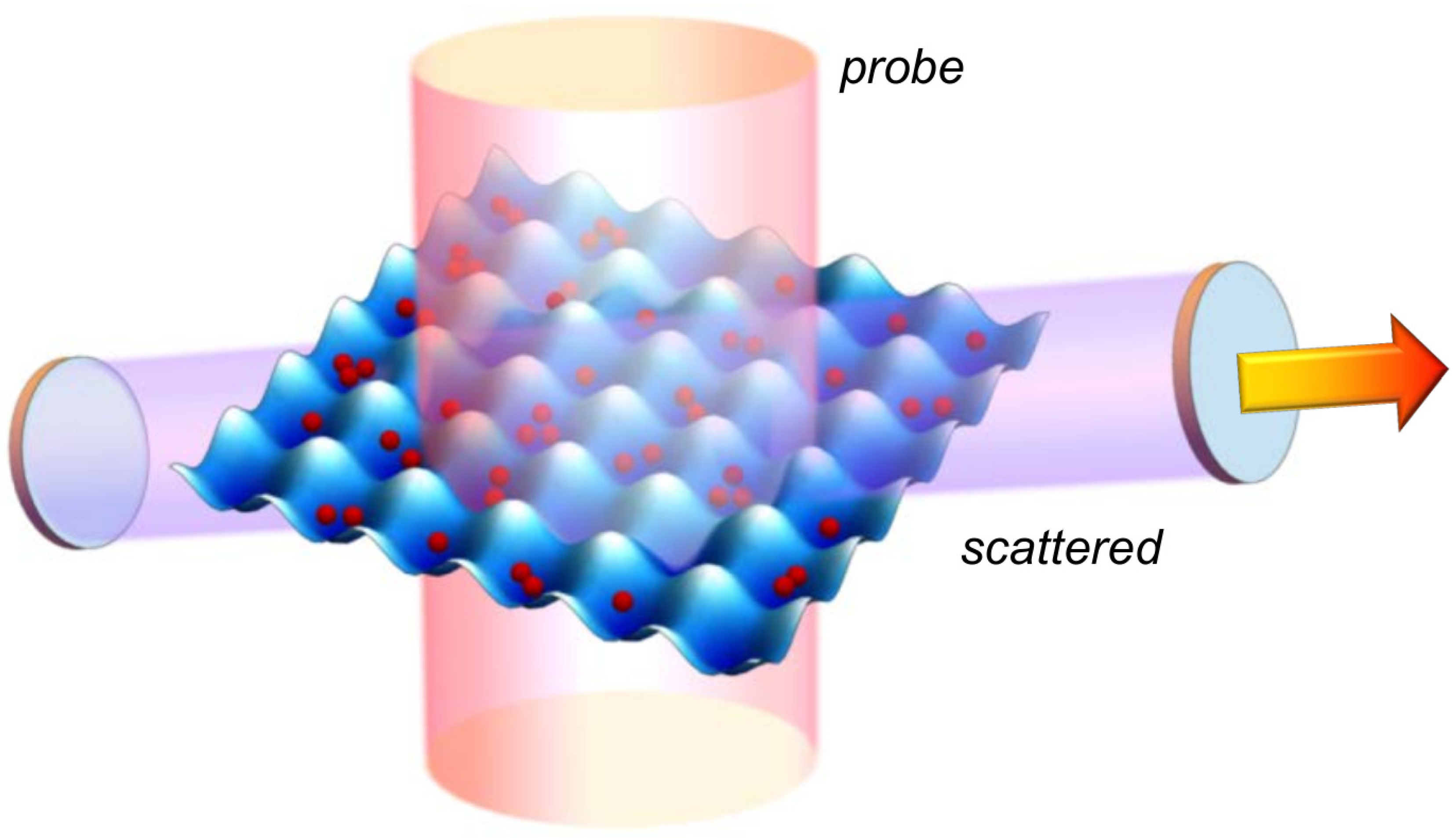
2. Quantum Nondemolition Probing of Many-Body States
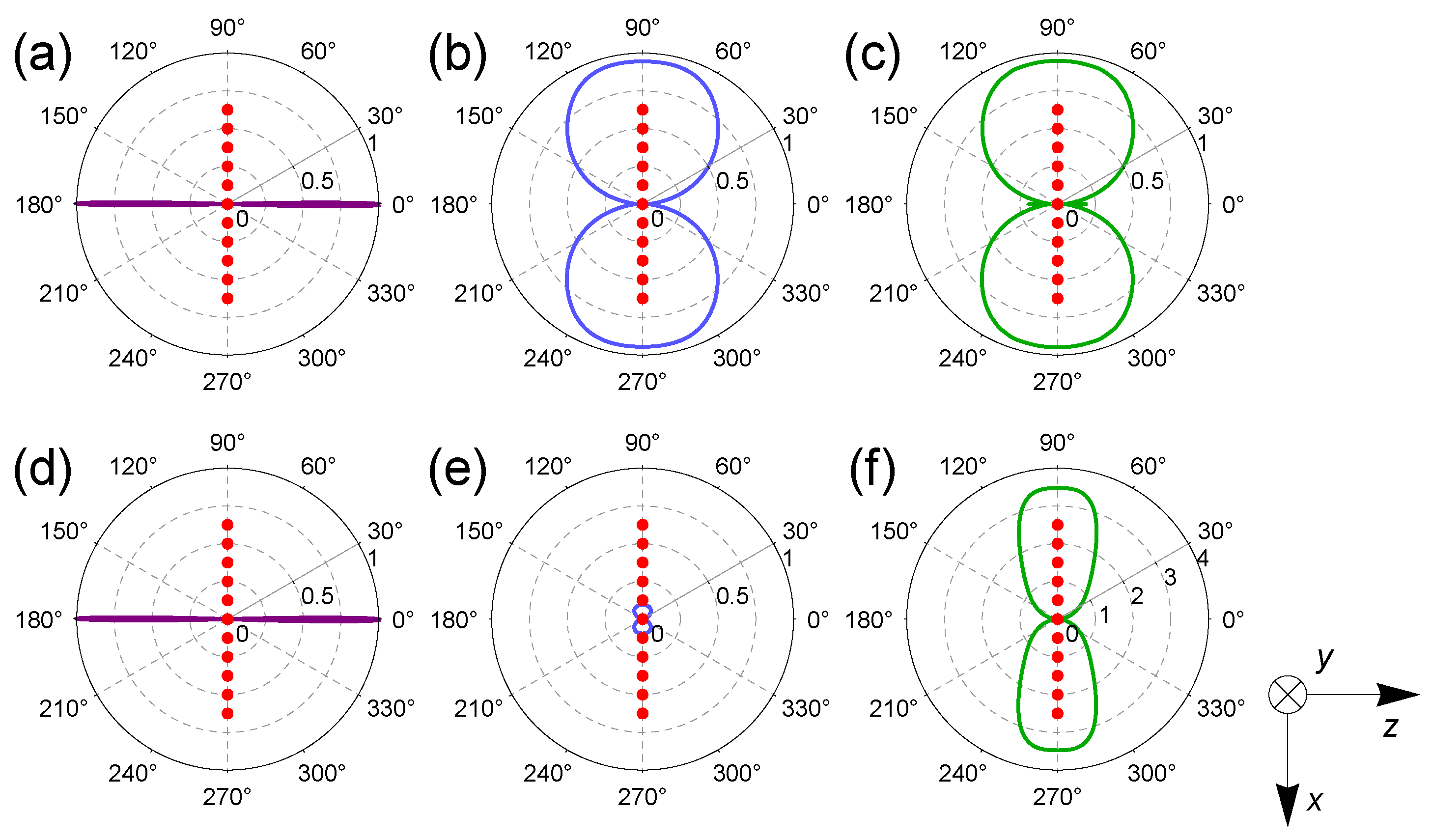
3. Measurement Backaction and State Preparation
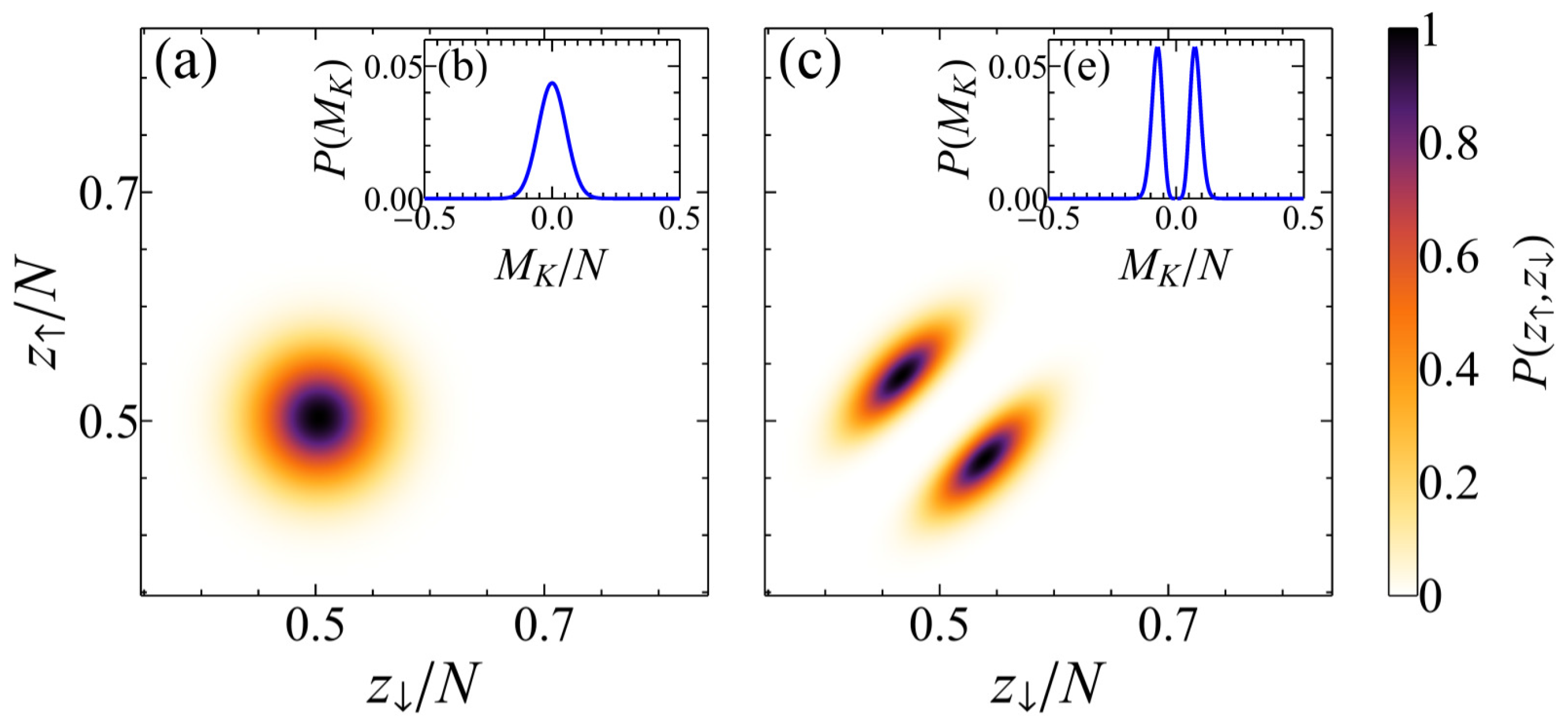
4. Light-Matter Entanglement
5. Homodyne Detection
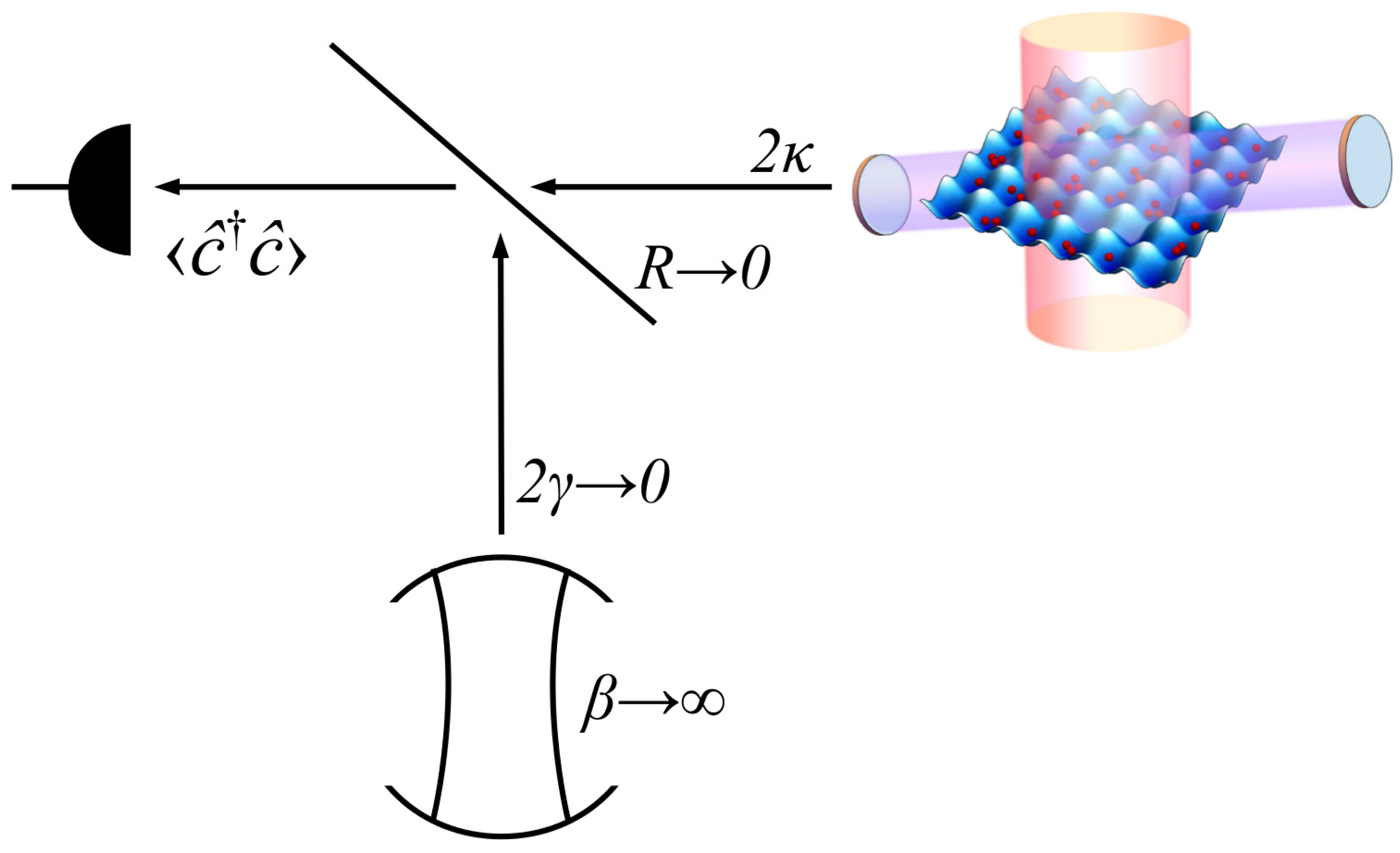
6. Quantum Optical Lattices
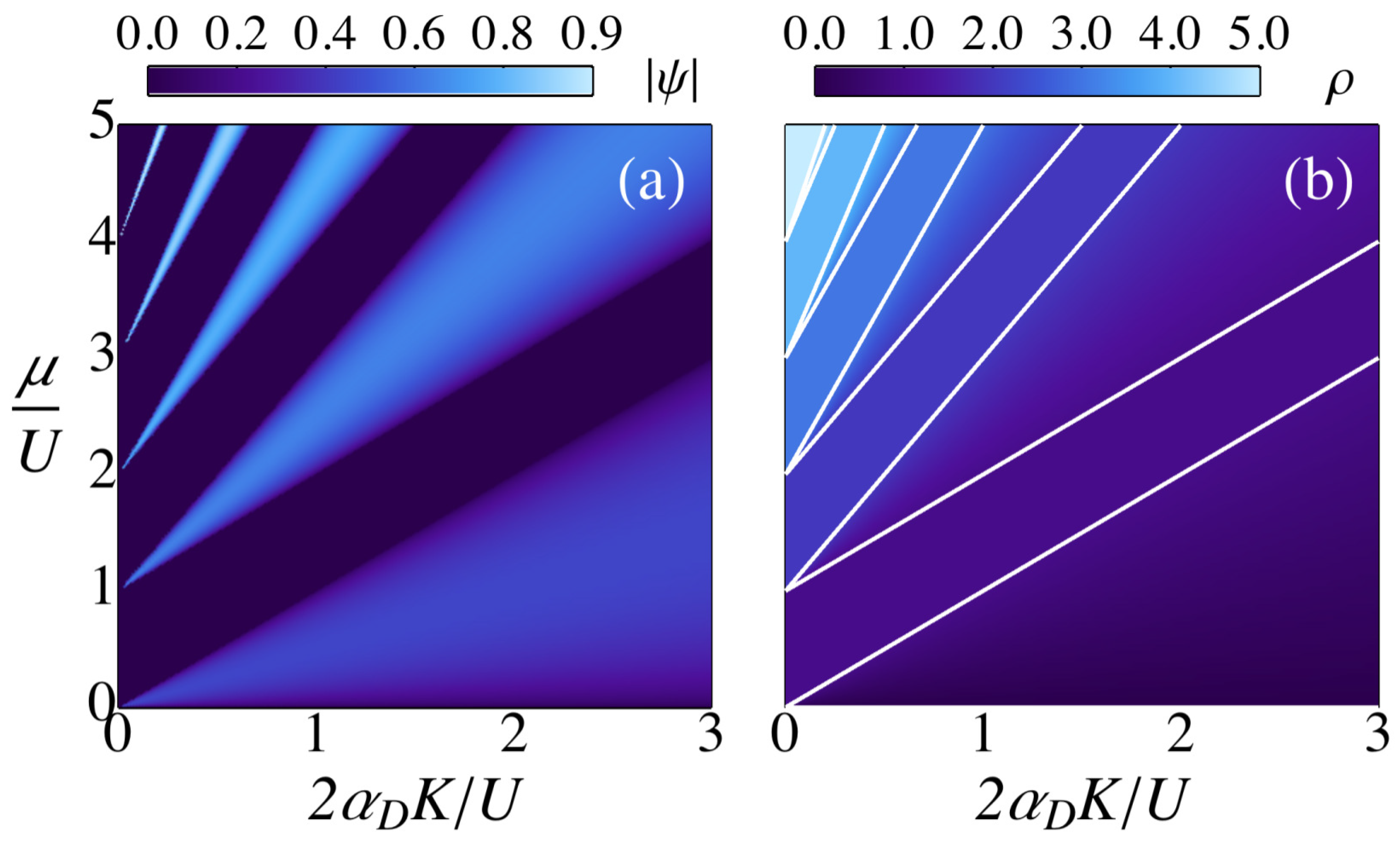
7. Conclusions
Acknowledgements
Author Contributions
Conflicts of Interest
References
- Lewenstein, M.; Sampera, A.; Ahufinger, V. Ultracold Atoms in Optical Lattices: Simulating Quantum Many-Body Systems; Oxford University Press: Oxford, UK, 2012. [Google Scholar]
- Mendoza-Arenas, J.J.; Grujic, T.; Jaksch, D.; Clark, S.R. Dephasing Enhanced Transport in Nonequilibrium Strongly Correlated Quantum Systems. Phys. Rev. B 2013, 87, 235130. [Google Scholar] [CrossRef]
- Javanainen, J.; Ruostekoski, J. Optical Detection of Fractional Particle Number in an Atomic Fermi-Dirac Gas. Phys. Rev. Lett. 2003, 91, 150404. [Google Scholar] [CrossRef] [PubMed]
- Mekhov, I.B.; Maschler, C.; Ritsch, H. Probing Quantum Phases of Ultracold Atoms in Optical Lattices by Transmission Spectra in Cavity QED. Nat. Phys. 2007, 3, 319–323. [Google Scholar] [CrossRef]
- Roscilde, T.; Rodriguez, M.; Eckert, K.; Romero-Isart, O.; Lewenstein, M.; Polzik, E.; Sanpera, A. Quantum Polarization Spectroscopy of Correlations in Attractive Fermionic Gases. New J. Phys. 2009, 11, 055041. [Google Scholar] [CrossRef]
- Rogers, B.; Paternostro, M.; Sherson, J.F.; de Chiara, G. Characterization of Bose-Hubbard Models with Quantum Nondemolition Measurements. Phys. Rev. A 2014, 90, 043618. [Google Scholar] [CrossRef]
- Cordobes Aguilar, F.; Ho, A.F.; Ruostekoski, J. Optical Signatures of Antiferromagnetic Ordering of Fermionic Atoms in an Optical Lattice. Phys. Rev. X 2014, 4, 031036. [Google Scholar] [CrossRef]
- Kozlowski, W.; Caballero-Benitez, S.F.; Mekhov, I.B. Probing Matter-Field and Atom-Number Correlations in Optical Lattices by Global Nondestructive Addressing. Phys. Rev. A 2015, 92, 013613. [Google Scholar] [CrossRef]
- Eckert, K.; Romero-Isart, O.; Rodriguez, M.; Lewenstein, M.; Polzik, E.S.; Sanpera, A. Dicke Quantum Phase Transition with a Superfluid Gas in an Optical Cavity. Nat. Phys. 2007, 4, 50–54. [Google Scholar] [CrossRef]
- Larson, J.; Damski, B.; Morigi, G.; Lewenstein, M. Mott-Insulator States of Ultracold Atoms in Optical Resonators. Phys. Rev. Lett. 2008, 100, 050401. [Google Scholar] [CrossRef] [PubMed]
- Chen, W.; Zhang, K.; Goldbaum, D.S.; Bhattacharya, M.; Meystre, P. Bistable Mott-Insulator-to-Superfluid Phase Transition in Cavity Optomechanics. Phys. Rev. A 2009, 80, 011801. [Google Scholar] [CrossRef]
- Fernández-Vidal, S.; de Chiara, G.; Larson, J.; Morigi, G. Quantum Ground State of Self-Organized Atomic Crystals in Optical Resonators. Phys. Rev. A 2010, 81, 043407. [Google Scholar] [CrossRef]
- Ivanov, D.; Ivanova, T. Feedback-Enhanced Self-Organization of Atoms in an Optical Cavity. JETP Lett. 2014, 100, 481–485. [Google Scholar] [CrossRef]
- Caballero-Benitez, S.F.; Mekhov, I.B. Quantum Optical Lattices for Emergent Many-Body Phases of Ultracold Atoms. 2015; arXiv:1504.06581. [Google Scholar]
- Sachdeva, R.; Ghosh, S. Hydrodynamic Theory of Rotating Ultracold Bose–Einstein Condensates in Supersolid Phase. J. Phys. B 2015, 48, 105301. [Google Scholar] [CrossRef]
- Ruostekoski, J.; Collett, M.J.; Graham, R.; Walls, D.F. Macroscopic Superpositions of Bose-Einstein Condensates. Phys. Rev. A 1998, 57, 511–517. [Google Scholar] [CrossRef]
- Bhattacherjee, A.B. Cavity Quantum Optomechanics of Ultracold Atoms in an Optical Lattice: Normal-Mode Splitting. Phys. Rev. A 2009, 80, 043607. [Google Scholar] [CrossRef]
- Mekhov, I.; Ritsch, H. Quantum Optics with Quantum Gases: Controlled State Reduction by Designed Light Scattering. Phys. Rev. A 2009, 80, 013604. [Google Scholar] [CrossRef]
- Mekhov, I.B.; Ritsch, H. Atom State Evolution and Collapse in Ultracold Gases during Light Scattering into a Cavity. Laser Phys. 2011, 21, 1486–1490. [Google Scholar] [CrossRef]
- Pedersen, M.K.; Sorensen, J.J.W.H.; Tichy, M.C.; Sherson, J.F. Many-Body State Engineering using Measurements and Fixed Unitary Dynamics. New J. Phys. 2014, 16, 113038. [Google Scholar] [CrossRef]
- Lee, M.D.; Ruostekoski, J. Classical Stochastic Measurement Trajectories: Bosonic Atomic Gases in an Optical Cavity and Quantum Measurement Backaction. Phys. Rev. A 2014, 90, 023628. [Google Scholar] [CrossRef]
- Mazzucchi, G.; Kozlowski, W.; Caballero-Benitez, S.F.; Elliott, T.J.; Mekhov, I.B. Quantum Measurement-Induced Dynamics of Many-Body Ultracold Bosonic and Fermionic Systems in Optical Lattices. 2015; arXiv:1503.08710. [Google Scholar]
- Elliott, T.J.; Kozlowski, W.; Caballero Benitez, S.F.; Mekhov, I.B. Multipartite Entangled Spatial Modes of Ultracold Atoms Generated and Controlled by Quantum Measurement. Phys. Rev. Lett. 2015, 114, 113604. [Google Scholar] [CrossRef] [PubMed]
- Mekhov, I.B.; Ritsch, H. Quantum Optics with Ultracold Quantum Gases: Towards the Full Quantum Regime of the Light-Matter Interaction. J. Phys. B 2012, 45, 102001. [Google Scholar] [CrossRef]
- Haroche, S.; Raimond, J.M. Exploring the Quantum: Atoms, Cavities, and Photons; Oxford University Press: Oxford, England, UK, 2006. [Google Scholar]
- Baumann, K.; Guerlin, C.; Brennecke, F.; Esslinger, T. Dicke Quantum Phase Transition with a Superfluid Gas in an Optical Cavity. Nature 2010, 464, 1301–1306. [Google Scholar] [CrossRef] [PubMed]
- Wolke, M.; Klinner, J.; Kessler, H.; Hemmerich, A. Cavity Cooling Below the Recoil Limit. Science 2012, 337, 85–87. [Google Scholar] [CrossRef] [PubMed]
- Schmidt, D.; Tomczyk, H.; Slama, S.; Zimmermann, C. Dynamical Instability of a Bose-Einstein Condensate in an Optical Ring Resonator. Phys. Rev. Lett. 2014, 112, 115302. [Google Scholar] [CrossRef] [PubMed]
- Ritsch, H.; Domokos, P.; Brennecke, F.; Esslinger, T. Cold Atoms in Cavity-Generated Dynamical Optical Potentials. Rev. Mod. Phys. 2013, 85, 553–601. [Google Scholar] [CrossRef]
- Greiner, M.; Regal, C.A.; Stewart, J.T.; Jin, D.S. Probing Pair-Correlated Fermionic Atoms through Correlations in Atom Shot Noise. Phys. Rev. Lett. 2005, 94, 110401. [Google Scholar] [CrossRef] [PubMed]
- Lee, Y.R.; Heo, M.S.; Choi, J.H.; Wang, T.T.; Christensen, C.A.; Rvachov, T.M.; Ketterle, W. Compressibility of an Ultracold Fermi Gas with Repulsive Interactions. Phys. Rev. A 2012, 85, 063615. [Google Scholar] [CrossRef]
- Meineke, J.; Brantut, J.P.; Stadler, D.; Müller, T.; Moritz, H.; Esslinger, T. Interferometric Measurement of Local Spin Fluctuations in a Quantum Gas. Nat. Phys. 2012, 8, 455–459. [Google Scholar] [CrossRef]
- Sanner, C.; Su, E.J.; Keshet, A.; Gommers, R.; Shin, Y.i.; Huang, W.; Ketterle, W. Suppression of Density Fluctuations in a Quantum Degenerate Fermi Gas. Phys. Rev. Lett. 2010, 105, 040402. [Google Scholar] [CrossRef] [PubMed]
- Sanner, C.; Su, E.J.; Keshet, A.; Huang, W.; Gillen, J.; Gommers, R.; Ketterle, W. Speckle Imaging of Spin Fluctuations in a Strongly Interacting Fermi Gas. Phys. Rev. Lett. 2011, 106, 010402. [Google Scholar] [CrossRef] [PubMed]
- Sanner, C.; Su, E.J.; Huang, W.; Keshet, A.; Gillen, J.; Ketterle, W. Correlations and Pair Formation in a Repulsively Interacting Fermi Gas. Phys. Rev. Lett. 2012, 108, 240404. [Google Scholar] [CrossRef] [PubMed]
- Brune, M.; Haroche, S.; Raimond, J.M.; Davidovich, L.; Zagury, N. Manipulation of Photons in a Cavity by Dispersive Atom-Field Coupling: Quantum-Nondemolition Measurements and Generation of “Schrödinger Cat” States. Phys. Rev. A 1992, 45, 5193–5214. [Google Scholar] [CrossRef] [PubMed]
- Mekhov, I.B.; Ritsch, H. Quantum Optics with Quantum Gases. Laser Phys. 2009, 19, 610–615. [Google Scholar] [CrossRef]
- Mekhov, I.B. Quantum Non-Demolition Detection of Polar Molecule Complexes: Dimers, Trimers, Tetramers. Laser Phys. 2013, 23, 015501. [Google Scholar] [CrossRef]
- Al-Assam, S.; Clark, S.R.; Jaksch, D.; TNT Development team. Tensor Network Theory Library. Available online: http://www.tensornetworktheory.org (Accessed on 1 September 2015).
- Mekhov, I.B.; Ritsch, H. Quantum Optical Measurements in Ultracold Gases: Macroscopic Bose–Einstein Condensates. Laser Phys. 2010, 20, 694–699. [Google Scholar] [CrossRef]
- Amico, L.; Fazio, R.; Osterloh, A.; Vedral, V. Entanglement in Many-Body Systems. Rev. Mod. Phys. 2008, 80, 517–576. [Google Scholar] [CrossRef]
- Boas, M.L. Mathematical Methods in the Physical Sciences; John Wiley & Sons., Inc.: Hoboken, NJ, USA, 2006. [Google Scholar]
- Carmichael, H. An Open System Approach to Quantum Optics; Springer: Berlin, Germany, 1993. [Google Scholar]
- Maschler, C.; Mekhov, I.B.; Ritsch, H. Ultracold Atoms in Optical Lattices Generated by Quantized Light Fields. Eur. Phys. J. D 2008, 46, 545–560. [Google Scholar] [CrossRef]
- Fisher, M.P.A.; Weichman, P.B.; Grinstein, G.; Fisher, D.S. Boson Localization and the Superfluid-Insulator Transition. Phys. Rev. B 1989, 40, 546–570. [Google Scholar] [CrossRef]
- Van Oosten, D.; van der Straten, P.; Stoof, H.T.C. Quantum Phases in an Optical Lattice. Phys. Rev. A 2001, 63, 053601. [Google Scholar] [CrossRef]
© 2015 by the authors; licensee MDPI, Basel, Switzerland. This article is an open access article distributed under the terms and conditions of the Creative Commons Attribution license (http://creativecommons.org/licenses/by/4.0/).
Share and Cite
Elliott, T.J.; Mazzucchi, G.; Kozlowski, W.; Caballero-Benitez , S.F.; Mekhov, I.B. Probing and Manipulating Fermionic and Bosonic Quantum Gases with Quantum Light. Atoms 2015, 3, 392-406. https://doi.org/10.3390/atoms3030392
Elliott TJ, Mazzucchi G, Kozlowski W, Caballero-Benitez SF, Mekhov IB. Probing and Manipulating Fermionic and Bosonic Quantum Gases with Quantum Light. Atoms. 2015; 3(3):392-406. https://doi.org/10.3390/atoms3030392
Chicago/Turabian StyleElliott, Thomas J., Gabriel Mazzucchi, Wojciech Kozlowski, Santiago F. Caballero-Benitez , and Igor B. Mekhov. 2015. "Probing and Manipulating Fermionic and Bosonic Quantum Gases with Quantum Light" Atoms 3, no. 3: 392-406. https://doi.org/10.3390/atoms3030392
APA StyleElliott, T. J., Mazzucchi, G., Kozlowski, W., Caballero-Benitez , S. F., & Mekhov, I. B. (2015). Probing and Manipulating Fermionic and Bosonic Quantum Gases with Quantum Light. Atoms, 3(3), 392-406. https://doi.org/10.3390/atoms3030392




